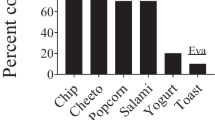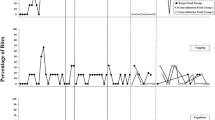Abstract
The participant was a boy diagnosed with autism spectrum disorder (ASD) who displayed severe food selectivity, which raised concerns about imbalanced nutrient consumption. The intervention used combined stimulus fading with simultaneous stimulus presentation without escape extinction (EE) and was implemented by teachers in a school setting. In intervention I, which used only stimulus fade-in of non-preferred foods, favorable results were not obtained. In intervention II, simultaneous stimulus presentation of a preferred food combined with stimulus fade-in of non-preferred foods, Silva’s consumption was stabilized at 100% consumption of three non-preferred foods. When intervention II was terminated, the child’s mother requested the inclusion of two additional non-preferred foods, so the intervention was extended based on a fading protocol planned with and to be used by the mother. The effects of the intervention were maintained at the 3-month post-intervention follow-up. The child’s parents and teachers showed high acceptance of this intervention. The current study offers further evidence that combining antecedent-based interventions without EE has the potential to yield favorable results with some children.

Similar content being viewed by others
References
Ahearn, W. H. (2003). Using simultaneous presentation to increase vegetable consumption in a mildly selective child with autism. Journal of Applied Behavior Analysis, 36, 361–365.
Bachmeyer, M. H. (2009). Treatment of selective and inadequate food intake in children: A review and practical guide. Behavioral Analysis in Practice, 2, 43–50.
Barahona, C., DuBard, M., Luiselli, J. K., & Kesterson, J. (2013). School-based feeding intervention to increase variety and quantity of foods consumed by an adolescent with autism. Clinical Practice in Pediatric Psychology, 1, 361–368.
Buckley, S. D., & Newchok, D. K. (2005). An evaluation of simultaneous presentation and differential reinforcement with response cost to reduce packing. Journal of Applied Behavior Analysis, 38, 405–409.
Freeman, K. A., & Piazza, C. C. (1998). Combining stimulus fading, reinforcement, and extinction to treat food refusal. Journal of Applied Behavior Analysis, 31, 691–694.
Gentry, J. A., & Luiselli, J. K. (2008). Treating a child’s selective eating through parent-implemented feeding intervention in the home setting. Journal of Developmental and Physical Disabilities., 20, 63–70.
Hoch, T. A., Babbitt, R. L., Coe, D. A., Krell, D. M., & Hackbert, L. (1994). Contingency contacting: Combining positive reinforcement and escape extinction procedures to treat persistent food refusal. Behavior Modification, 18, 106–128.
Ikuzawa, M., Matsushita, Y., & Nakase, A. (2002). Kyoto scale of psychological development 2001. Kyoto: Kyoto International Social Welfare Exchange Centre.
Kadey, H. J., Roane, H. S., Diaz, J. C., & Merrow, J. M. (2013). An evaluation of chewing and swallowing for a child diagnosed with autism. Journal of Developmental and Physical Disabilities, 25, 343–354.
Kelley, M. L., Heffer, R. W., Gresham, F. M., & Elliott, S. N. (1989). Development of a modified treatment evaluation inventory. Journal of Psychopathology and Behavioral Assessment, 11, 235–247.
Knox, M., Rue, H. C., Wildenger, L., Lamb, K., & Luiselli, J. K. (2012). Intervention for food selectivity in a specialized school setting: Teacher implemented prompting, reinforcement, and demand fading for an adolescent student with autism. Education and Treatment of Children, 35, 407–417.
Langthorne, P., & McGill, P. (2011). Assessing the social acceptability of the functional analysis of problem behavior. Journal of Applied Behavior Analysis, 44, 403–407.
Levin, L., & Carr, E. G. (2001). Food selectivity and problem behavior in children with developmental disabilities: Analysis and intervention. Behavior Modification, 25, 443–470.
Luiselli, J. K. (2006). Pediatric feeding disorders. In J. K. Luiselli (Ed.), Antecedent assessment and intervention: Supporting children and adults with developmental disabilities in community settings (pp. 165–185). Baltimore: Brookes.
Luiselli, J. K., Ricciardi, J. N., & Gilligan, K. (2005). Liquid fading to establish milk consumption by a child with autism. Behavioral Interventions, 20, 155–163.
Lukens, C. T., & Linscheid, T. R. (2008). Development and validation of an inventory to assess mealtime behavior problems in children with autism. Journal of Autism and Developmental Disorders, 38, 342–352.
Miltenberger, R. G. (2008). Antecedent control procedures. In R. G. Miltenberger (Ed.), Behavior modification: Principles and procedures (4th edition) (pp. 359–383). Belmont: Wadsworth.
Nagai, Y. (1983). The characteristics and mechanism of food preference in infantile autism. Japanese Journal of Child and Adolescent Psychiatry, 24, 260–278.
Najdowski, A. C., Wallace, M. D., Doney, J. K., & Ghezzi, P. M. (2003). Parental assessment and treatment of food selectivity in natural settings. Journal of Applied Behavior Analysis, 36, 383–386.
Najdowski, A. C., Tarbox, J., & Wilke, A. E. (2012). Utilizing antecedent manipulations and reinforcement in the treatment of food selectivity by texture. Education and Treatment of Children, 35, 101–110.
Patel, M. R., Piazza, C. C., Kelly, L., Ochsner, C. A., & Santana, C. M. (2001). Using a fading procedure to increase fluid consumption in a child with feeding problems. Journal of Applied Behavior Analysis, 34, 357–360.
Piazza, C. C., Patel, M. R., Gulotta, C. S., Sevin, B. M., & Layer, S. A. (2003). On the relative contributions of positive reinforcement and escape extinction in the treatment of food refusal. Journal of Applied Behavior Analysis, 36, 309–324.
Piazza, C. C., Patel, M. R., Santana, C. M., Goh, H. L., Delia, M. D., & Lancaster, B. M. (2002). An evaluation of simultaneous and sequential presentation of preferred and nonpreferred food to treat food selectivity. Journal of Applied Behavior Analysis, 35, 259–270.
Riordan, M. M., Iwata, B. A., Wohl, M. K., & Finney, J. W. (1980). Behavioral treatment of food refusal and selectivity in developmentally disabled children. Applied Research in Mental Retardation, 1, 95–112.
Schopler, E., Reichler, R., & Renner, B. (1986). The childhood autism rating scale (CARS) Japanese version. New York: Irvington.
Sharp, W. G., Berry, R. C., McCracken, C., Nuhu, N. N., Marvel, E., Saulnier, C. A., Klin, A., Jones, W., & Jaquess, D. L. (2013). Feeding problems and nutrient intake in children with autism spectrum disorders: a meta-analysis and comprehensive review of the literature. Journal of Autism Developmental Disorders, 43, 2159–2173.
Shore, B. A., Babbitt, R. L., Williams, K. E., Coe, D. A., & Snyder, A. (1998). Use of texture fading in the treatment of food selectivity. Journal of Applied Behavior Analysis, 31, 621–633.
Sira, B. K., & Fryling, M. J. (2012). Using peer modeling and differential reinforcement in the treatment of food selectivity. Education and Treatment of Children, 35, 91–100.
Sparrow, S. S., Cicchetti, V. D., & Balla, A. D. (2005). Vineland adaptive behavior scales (2nd edition) Japanese version. Circle Pines: American Guidance Service.
Volkert, V. M., & Piazza, C. C. (2012). Empirically supported treatment for pediatric feeding disorders. In P. Sturmey & M. Hersen (Eds.), Handbook of evidence-based practice in clinical psychology Vol. 1, Child and Adolescent Disorders (pp. 323–337). Hoboken: John Wiley & Sons.
Volkert, V. M., Patel, C. C., & Peterson, K. M. (2016). Food refusal and selective eating. In J. K. Luiselli (Ed.), Behavioral Health Promotion and Intervention in Intellectual and Developmental Disabilities (pp. 137–161). Cham: Springer International Publishing AG.
Author information
Authors and Affiliations
Corresponding author
Additional information
This research was supported in part by the Rotary Yoneyama Memorial Foundation
Rights and permissions
About this article
Cite this article
Cho, S., Sonoyama, S. Combining Stimulus Fading with Simultaneous Stimulus Presentation in a School Setting for Food Selectivity in a Child with Autism Spectrum Disorder. Educ. Treat. Child. 43, 335–345 (2020). https://doi.org/10.1007/s43494-020-00011-5
Published:
Issue Date:
DOI: https://doi.org/10.1007/s43494-020-00011-5




